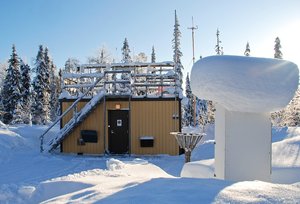Oulanka Research Station

Address
Oulanka Research StationLiikasenvaarantie 134
93900 Kuusamo
Finland
Station manager
Riku PaavolaStation Features
Opening year: 1966 Status: OpenFacilities
Station name and owner
Oulanka Research Station was founded in 1966. It belongs to the Thule Institute, and is a regional unit of the University of Oulu in Kuusamo, Finland.
Location
Oulanka Research Station is situated in the river valley of Oulanka within the Oulanka National Park (66°22’ N, 29°19’ E, 167 m a.s.l.). The station is located c. 25 km south of the Arctic Circle, 13 km west of the Russian border, about 280 km northeast of Oulu, and 55 km north of Kuusamo.
Climate data
Grey colours are WMO Climate Normals including maximum and minimum values. Blue colours are individual years.
Climate data for the stations where extracted via Copernicus Climate Data Store, from the global gridded reanalysis product:
ERA5 monthly averaged data on single levels from 1940 to present.
Description and source code: Roemer J.K. 2023. https://doi.org/10.5281/zenodo.10214922
Data Source: Hersbach et al. 2023. Copernicus Climate Change Service (C3S) Climate Data Store (CDS), https://doi.org/10.24381/cds.f17050d7
Biodiversity and natural environment
Oulanka Research Station operates and offers access to visitors throughout the year. The station is a primary location for field courses at Oulu University (especially biology and geography) with 5-8 different courses and roughly 1500 person-days per year. The station lies in the heart of the Oulanka National Park at an optimal distance to various field research locations. Being a multi-disciplinary research station, Oulanka is open to almost all kinds of research activities. The station has 82 beds, two well-equipped laboratories, an auditorium, classrooms, workshops, and high-speed internet.
History and facilities
Oulanka National Park is a northern biodiversity hot-spot, thanks to the calcium-rich bedrock, varying topography, and large environmental gradients within a small area. Moreover, it has historically been at the cross-roads for movement of northern, southern and eastern species. Unlike most of Finland, the local rivers drain towards the northeast, i.e. to the White Sea.
General research and databases
The study area includes the towns of Kuusamo, Posio, Taivalkoski, and Salla and covers an area of roughly 100 × 200 km. Most of the research activity is concentrated in and around the Oulanka National Park. Historically research has been focused on animal and plant ecology as well as geography. Recently sociological aspects have been included as well. Oulanka has a broad range of long-term data series available for researchers. These include both biological and physical/chemical datasets, and many of them have been collected since 1966. The datasets cover time-series on meteorology, water chemistry of streams and lakes, phenology, ice cover, snow cover, active layer depth, air pollution, as well as different plant and animal species, etc. Oulanka also offers a recently acquired, extremely comprehensive (70 × 90 km) set of high-resolution aerial photographs covering three different areas, i.e. the early 1950’s, the early 1980’s, and c. 2005.
Link to data: https://dataportal.eu-interact.org/stations
Station Monitoring
Human dimension
The nearest village with stores and services is 13 km away, while the ski centre of Ruka is 30 km away. Outside the villages and towns, the area is sparsely populated, but tourism is an important activity with associated impacts on nature. In addition to tourism, forestry, and mining are the other major human impacts in the area.
Access
Oulanka Research Station can be reached by car, by bus, or by plane to Kuusamo (55 km from the station) year-round.

